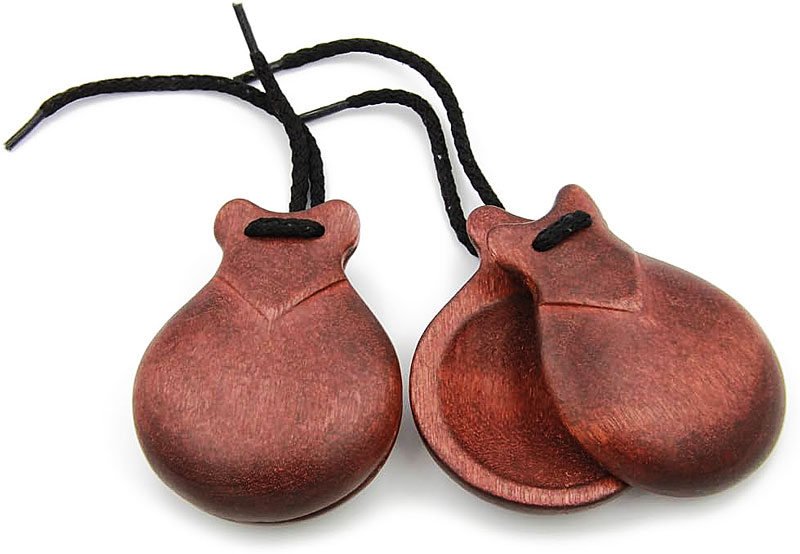(Headline image semi-professional Jale Spanish flamenco castanets – Castañuelas)
The castañuelas (castanets), are a percussion instrument consisting of two wooden pieces connected by a cord. They date back over 3,000 years, with origins tracing to the Phoenicians. Other ancient civilizations, including the Egyptians, used similar percussion instruments in religious and funerary rituals.
Through trade, castañuelas spread across Mediterranean countries such as modern-day Croatia and southern Italy. However, Spain has preserved and developed the instrument, making it a national symbol alongside the Spanish guitar. Moreover, castañuelas have also been historically significant in Portugal, Persia, and Germany.
Castañuelas are traditionally made from various types of wood, including ebony, granadillo, caoba (mahogany), palo santo, box tree and walnut, and compressed fabric, which produces sharper sounds. Modern versions also use fiber, glass, and metal. They are held by a cord looped around the thumb, allowing the halves to strike against each other through finger and wrist movements. Additionally, some variations attach the pieces to a handle for easier use.
Each pair consists of two tones: the lower-pitched “macho” (male) and the higher-pitched “hembra” (female). The higher tone is played with the right hand, while the lower tone is played with the left. A physical notch on the right-hand castañuela distinguishes it from the left.
During the Baroque era, Spanish guitarist and composer Santiago de Murcia incorporated castañuelas into his “jácaras” and fandangos around 1730. Luigi Boccherini, an Italian composer residing in Spain, featured the instrument in a quintet performed for Infante Luis de Borbón in 1798. Richard Wagner briefly included castañuelas in the Venusberg music of his 1845 opera Tannhäuser. In the 20th century, composer Joaquín Rodrigo created Dos Danzas Españolas for castañuelas and orchestra, premiered in 1966.
With the advent of sound cinema in the 1920s, castañuelas gained prominence in film. Conchita Piquer played them in an early synchronized sound test in 1923. Flamenco dancer Carmen Amaya featured them in La hija de Juan Simón (1935), María de la O (1936), and Los amores de un torero (1945).
Regional Variations and Notable Performers
Castañuelas are widely used in Spanish folk music, particularly in Asturias, Galicia, Cantabria (Tarrañuilas), Aragón, Ibiza, and the Canary Islands, where they are called “chácaras.” In Murcia, Valencia, Almería, and parts of Castilla-La Mancha, they are known as “postizas.”
Prominent concert performers include Carmen Amaya, Lucero Tena, Emma Maleras, Antonio Ruiz Soler, Tomás de Antequera, Scarlett Ketty Pazmiño Bravo, Mercedes Rubio, Margarita Guerra, Antonio Najarro, Carmen de Vicente, Inma González, Mariemma, Belén Cabanes, Gaby Herzog, Teresa Laiz Monsalve, Tomás Martín, Jimena Zaras, José de la Vega, Mar Bezana, Gamaliel Burgos, Amparo de Triana, Graciela Ríos Saiz, and Nina Corti. Meanwhile, Vicente Escudero introduced metal versions made from aluminum and bronze.
Playing Technique and Learning Process
Mastering castañuelas requires structured training, often taking six years of study with daily practice. The instrument comes in various sizes to fit different hand dimensions. Beginners typically use plastic “pollopas,” while professionals commission custom-made concert-quality versions.
Each castañuela produces distinct sounds, with the “hembra” on the right hand and the “macho” on the left. Players execute rhythmic sequences using five primary strokes:
RI: A four-finger stroke played exclusively with the right hand.
A: A stronger strike by the left hand’s index and middle fingers.
PI: A simultaneous strike using the right hand’s middle and ring fingers.
TA: A simultaneous hit by both hands.
CHI: A direct collision of the two castañuelas, often followed by TA.
Other castanets
In Morocco, the karkabas, a set of large metal castanets, is widely used by Gnawa musicians and has been adopted by many musicians from northwestern Africa and the diaspora in Europe.
Castanet Festivals and Competitions
Spain hosts castanet festivals such as the annual Festival Internacional de Castanuelas (International Castañuela Festival) curated by castanet master player Teresa Laiz. Recent editions took place in Madrid, with workshops in Avila.
Meanwhile, the Concurso Internacional de Castañuelas (International Castañuela Competition), also directed by Teresa Laiz, recognizes the finest players.
also known as palillos,


